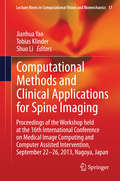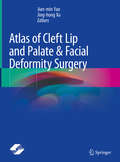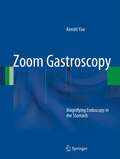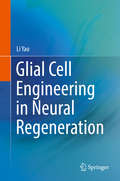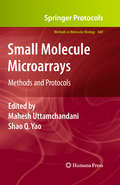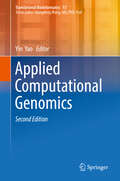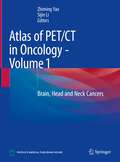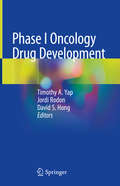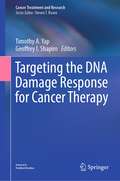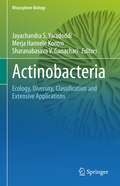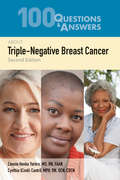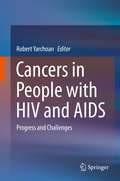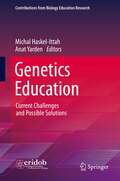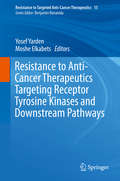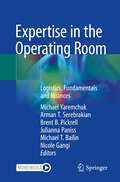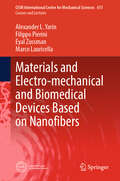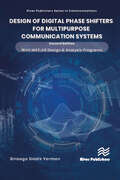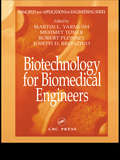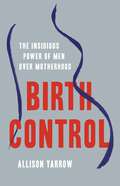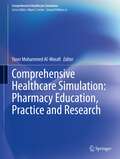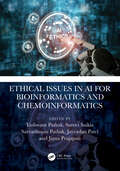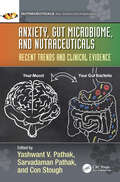- Table View
- List View
Computational Methods and Clinical Applications for Spine Imaging: Proceedings of the Workshop held at the 16th International Conference on Medical Image Computing and Computer Assisted Intervention, September 22-26, 2013, Nagoya, Japan (Lecture Notes in Computational Vision and Biomechanics #17)
by Jianhua Yao Tobias Klinder Shuo LiThis book contains the full papers presented at the MICCAI 2013 workshop Computational Methods and Clinical Applications for Spine Imaging. The workshop brought together researchers representing several fields, such as Biomechanics, Engineering, Medicine, Mathematics, Physics and Statistic. The works included in this book present and discuss new trends in those fields, using several methods and techniques in order to address more efficiently different and timely applications involving signal and image acquisition, image processing and analysis, image segmentation, image registration and fusion, computer simulation, image based modelling, simulation and surgical planning, image guided robot assisted surgical and image based diagnosis.
Atlas of Cleft Lip and Palate & Facial Deformity Surgery
by Jian-Min Yao Jing-Hong XuThis book consists the basic theories and comprehensive skills of surgery, plastic surgery and chin surgery. The book contains more than 1900 color surgical photos, which mainly from lip and palate surgery in “Operation Smile” and the accumulation in decades of clinical practice. It briefly introduces various surgical methods of cleft lip and palate and alternative methods, procedures and steps of recommended repair surgeries by the way of pictures and graphic. It also emphasizes on describing common and practical cleft lip and palate surgery, and explores innovative surgical methods, operative techniques and key points. By means of schematic diagrams and surgical photos, various surgical procedures for cleft lip and palate are introduced. It is a useful reference book for surgeons in plastic surgery, oral surgery, cosmetic surgery and otolaryngology.
Zoom Gastroscopy
by Kenshi YaoSince magnifying endoscopy of the stomach, or zoom gastroscopy, was first performed at the beginning of the 21st century , there have been numerous findings in the field worldwide. The author of this volume has developed a standardized magnifying endoscopy technique that enables endoscopists to constantly visualize the microanatomy (subepithelial capillaries and the epithelial structure) within the stomach. With this technology, it has become easy to obtain magnified endoscopic findings. Techniques differ, however, depending upon the endoscopist. Endoscopists around the world do not have a standardized magnifying endoscopy technique, which is mandatory for the scientific analysis of their findings. In addition, there is no logical explanation for how and which microanatomies are visualized by magnifying endoscopy with narrow-band imaging in the glandular epithelium of the stomach. This inconsistency results in considerable confusion among researchers and clinicians and a lack of terminology for the purposes of analysis. As magnifying endoscopy with narrow-band imaging (NBI) becomes more popular throughout the world, there is increased demand for a specialized reference book focused on this subject. The aims of the present volume, Zoom Gastroscopy: Magnifying Endoscopy in the Stomach, are manifold: (1) to illustrate the standard magnifying endoscopic technique that can visualize subepithelial mucosal microvessels as small as capillaries, the smallest unit of blood vessels in the human body, (2) to explain the optical phenomena and principles for NBI and its application to magnifying endoscopy, (3) to clarify which microanatomies are visualized by magnifying endoscopy with NBI and how this is achieved, and (4) to present a diagnostic system so called "VS classification system" for early gastric neoplasias. With a single author, the book consistently uses uniform anatomical terms to describe endoscopic findings, providing an essential reference for endoscopists in the world.
Glial Cell Engineering in Neural Regeneration
by Li YaoThis book focuses on current applications of glial cells in neural regeneration, especially in spinal cord repair. It introduces the application of a few types of glial cells including oligodendrocyte, astrocyte, Schwann cells, and stem cell derived glial cells in neural regeneration. The latest glial cell research with biomaterials, gene modification, and electrical signals is also summarized. This is an ideal book for undergraduate and research students in tissue engineering, neurobiology, and regenerative medicine as well as researchers in the field.
Clinical Radiation Oncology: Indications, Techniques, and Results
by Min Yao Nancy J. Tarbell William Small Jr.This fully updated and enhanced third edition offers a highly practical, application-based review of the biological basis of radiation oncology and the clinical efficacy of radiation therapy. Revised edition of the classic reference in radiation oncology from Dr. C.C. Wang, whose practical approach to clinical application was legendary Includes the latest developments in the field: intensity modulated radiation therapy (IMRT), image guided radiation therapy, and particle beam therapy Includes two brand new chapters Palliative Radiotherapy, and Statistics in Radiation Oncology Features a vibrant and extremely comprehensive head and neck section Provides immediately applicable treatment algorithms for each tumor
Small Molecule Microarrays
by Shao Q. Yao Mahesh UttamchandaniSmall molecule microarrays (SMM) were introduced just a decade ago in 1999 and, within a short space of time, have already established themselves as a vibrant, next generation platform for high-throughput screening. Small Molecule Microarrays: Methods and Protocols showcases a collection of contributions guiding researchers toward ways in which small molecule microarray technology may be deployed for multiplexed screening and profiling. Organized by the categories of small molecules presented on the microarrays, this detailed volume describes in-depth techniques for chemical libraries, peptide libraries, and carbohydrate microarrays. Written in the highly successful Methods in Molecular BiologyTM series, chapters contain brief introductions to their respective topics, lists of the necessary materials and reagents, step-by-step, readily reproducible protocols, vital tips on troubleshooting this often difficult technology, and advice on avoiding known pitfalls. Authoritative and cutting-edge, Small Molecule Microarrays: Methods and Protocols provides meticulous depictions of key hands-on experience and seeks to inspire a future generation of microarray practitioners to take this significant technology forward.
Applied Computational Genomics (Translational Bioinformatics Ser. #1)
by Yin YaoThe volume provides a review of statistical development and application in the area of human genomics, including candidate gene mapping, linkage analysis, population-based genome-wide association, exon sequencing, and whole genome sequencing analysis. The authors are extremely experienced in the field of statistical genomics and will give a detailed introduction to the evolution of the field, as well as critical comments on the advantages and disadvantages of the proposed statistical models. The future directions of translational biology will also be described.
Atlas of PET/CT in Oncology - Volume 1: Brain, Head and Neck Cancers
by Zhiming Yao Sijin LiThe atlas aims to help practitioners to interpret PET/CT images of tumors in brain, head and neck in a timely and accurate way. Illustrating in a case-based manner, the PET/CT appearances of glioma, meningioma, nasopharyngeal carcinoma, eye tumors, ear and temporal bone tumors, and neck tumors are covered. Each chapter is organized in the same format of clinical overview, PET/CT diagnosis, typical/atypical/confusing manifestation of the diseases. This book will be a useful reference to residents and practitioners in nuclear medicine, radiology, oncology, radiation oncology and nuclear medicine technology.
Phase I Oncology Drug Development
by Timothy A. Yap Jordi Rodon David S. HongThis book provides a detailed review of how oncology drug development has changed over the past decade, and serves as a comprehensive guide for the practicalities in setting up phase I trials. The book covers strategies to accelerate the development of novel antitumor compounds from the laboratory to clinical trials and beyond through the use of innovative mechanism-of-action pharmacodynamic biomarkers and pharmacokinetic studies. The reader will learn about all aspects of modern phase I trial designs, including the incorporation of precision medicine strategies, and approaches for rational patient allocation to novel anticancer therapies. Circulating biomarkers to assess mechanisms of response and resistance are changing the way we are assessing patient selection and are also covered in this book. The development of the different classes of antitumor agents are discussed, including chemotherapy, molecularly targeted agents, immunotherapies and also radiotherapy. The authors also discuss the lessons that the oncology field has learnt from the development of hematology-oncology drugs and how such strategies can be carried over into therapies for solid tumors. There is a dedicated chapter that covers the specialized statistical approaches necessary for phase I trial designs, including novel Bayesian strategies for dose escalation. This volume is designed to help clinicians better understand phase I clinical trials, but would also be of use to translational researchers (MDs and PhDs), and drug developers from academia and industry interested in cancer drug development. It could also be of use to phase I trial study coordinators, oncology nurses and advanced practice providers. Other health professionals interested in the treatment of cancer will also find this book of great value.
Targeting the DNA Damage Response for Cancer Therapy (Cancer Treatment and Research #186)
by Timothy A. Yap Geoffrey I. ShapiroThis book discusses the latest developments in Poly (ADP-ribose) polymerase (PARP) inhibitor drug development. It focuses on the translational and clinical development of the latest drugs, as well as the evidence for regulatory approval of PARP inhibitors in multiple different molecular subtypes and tumor indications. The most-up-to-date information on basic scientific research on DNA repair pathways and the DNA Damage Response (DDR) is also covered. Every chapter contains insight into the preclinical, translational along with clinical aspects of a specific DDR inhibitor with key and expert opinion points reinforcing the most important concepts detailed to enable the reader to develop a deep understanding of the topic.Targeting the DNA Damage Response for Cancer Therapy comprehensively reviews the application of PARP and other DDR inhibitors across oncology disciplines. Therefore, it is a valuable resource for all medical professionals and researchers who use or who are researching the use of these inhibitors on a day-to-day basis.
Using Hypnosis with Children: Creating and Delivering Effective Interventions
by Michael D. Yapko Lynn LyonsHow to create and deliver effective hypnotic interventions with children. From the initial interview to creating the best metaphors, Using Hypnosis with Children is a practical, step-by-step guide that shows health care providers (including therapists, nurses, pediatricians, dentists, and educators) how to create and deliver hypnotic interventions that are customized and effective into their pediatric clinical work, with utilization and flexibility as key components to an overall treatment approach. Using case examples of language for all age groups, readers learn first how to identify the salient targets or themes, deliver a session that hits these targets with precision, and then connect the session to the child's everyday experience. More broadly, readers learn to use hypnosis as a way to help create new neural pathways, teach self-regulation, introduce a more internal locus of control, and develop positive interpersonal experiences. Chapters focus on the most common issues that children face, including anxiety, depression, medical procedures/pain, and sleep.
Actinobacteria: Ecology, Diversity, Classification and Extensive Applications (Rhizosphere Biology)
by Jayachandra S. Yaradoddi Merja Hannele Kontro Sharanabasava V. GanachariThrough this book, the readers will learn about the different aspects of Actinobacteria- beginning with its ecology and occurrence, to the ways of its adaptation to harsh climates, and finally to its practical applications. The book also presents methods of identifying and characterizing this diverse group of bacteria through advanced techniques like MALDI-TOF, 16S rRNA analysis, etc. Different chapters describe the various biotechnological applications of Actinobacteria, including bioremediation, secondary metabolite production, and in producing antibiotics, anti-cancer therapeutics. It also provides insights into the applications in agriculture and forestry by inhibiting plant pathogenic bacteria's growth.
100 Questions & Answers About Triple-Negative Breast Cancer
by Connie Henke Yarbro Cynthia CantrilAccording to the American Cancer Society, 10-15% of all breast cancer patients are diagnosed with triple-negative breast cancer (TNBC). No one with TNBC needs to be alone in their fight against this fast-growing cancer. That's where this book and the information within can help. 100 Questions & Answers About Triple-Negative Breast Cancer offers authoritative and practical answers to the most common questions asked by patients and their loved ones. What is triple-negative breast cancer? How is different than other breast cancers? What are the signs and symptoms of triple-negative breast cancer? What is targeted therapy and is it effective treatment for TNBC? Along with the answers to these and other questions, this book provides information on risk factors and prevention, diagnosis, treatment, survivorship, and more. 100 Questions & Answers About Triple-Negative Breast Cancer, Second Edition is an invaluable resource for anyone copying with this type of breast cancer.
Cancers in People with HIV and AIDS: Progress and Challenges
by Robert YarchoanThe association between AIDS and cancer was recognized from the beginning of the AIDS epidemic, when the appearance of Kaposi sarcoma in a cluster of young men was one of the first signs of this new disease. It was soon recognized that AIDS was caused by infection with a novel virus (HIV) and that AIDS patients are prone to develop a number of "AIDS-defining" cancers: Kaposi sarcoma, lymphoma, and cervical cancer. The development of effective combination anti-HIV therapy starting around 1996 converted AIDS from a death sentence to a manageable disease and led to dramatic shifts in the epidemic. As this therapy was able to improve immune function in patients, the incidence of most "AIDS-defining" cancers decreased. There is a misconception, however, that AIDS has gone away. In fact, as AIDS patients are living longer, the number of AIDS patients has more than doubled in the United States since 1996, and the AIDS population overall has increased in age. Also, as AIDS patients are less likely to die of other complications, cancer is coming to the forefront as one of the most common causes of death in regions where AIDS drugs are widely available. Moreover, the three "AIDS-defining" cancers are now taking a back seat to a number of other HIV-associated cancers, such as Hodgkin lymphoma, lung cancer, and anal cancer. In the developing world, AIDS-associated cancers are a major public health problem, and in some regions of sub-Saharan Africa, Kaposi sarcoma is the most common tumor in men. In recent years, there has been a vast increase in our understanding of HIV-associated cancers. We now know, for example, that most are caused by other viruses and that the main role of HIV and immunodeficiency is to provide a supportive environment for the viruses to multiply and for the cancers to develop. But there remain a number of unanswered questions and a need for improved prevention and therapy. In the 28 chapters of this book, written by some of the most renowned experts in this field, we present up-to-date information on the cancers associated with HIV infection The chapters cover the epidemiology of these cancers, their pathogenesis, their clinical presentation, and their treatment. The book will be of value to physicians, other medical professionals, students, and researchers with an interest in AIDS, viral-associated cancers, or HIV-associated malignancies. TABLE OF CONTENTS 1. HIV-associated Cancers: Overview Robert Yarchoan, Thomas Uldrick, Mark Polizotto 2. Epidemiology of AIDS-defining Malignancies William A. Blattner and Rebecca G. Nowak 3. Epidemiology of non-AIDS Defining Malignancies Andrew E. Grulich 4. HIV Cancers in Resource-Limited Regions Sam M. Mbulaiteye 5. Kaposi''s Sarcoma-associated Herpesvirus (KSHV) Blossom Damania and Dirk P. Dittmer 6. Epstein Barr Virus (EBV) Lindsey Hutt-Fletcher 7. Human Papillomavirus (HPV) Zhi-Ming Zheng 8. Merkel Cell Polymavirus (MCV) Nicole Fischer and Adam Grundhoff 9. Presentation and Pathogenesis of Kaposi''s Sarcoma Corey Casper 10. Management of Kaposi''s Sarcoma Susan E. Krown 11. Presentation and Pathogenesis of HIV Lymphomas Richard F. Little, Stefania Pittaluga, Kieron Dunleavy 12. Diffuse Large B-Cell Lymphoma Neel K. Gupta and Lawrence D. Kaplan 13. Burkitt and Burkitt-Like Lymphoma Kishor Bhatia and Sam M. Mbulaiteye 14. Primary Effusion Lymphoma Giovanna Tosato 15. AIDS-related Central Nervous System Lymphoma Jan Davidson-Moncada and Thomas Uldrick 16. Plasmablastic and Other Lymphomas Huan-You Wang, Ida Wong-Sefidan, Erin Reid 17. Hodkin Lymphoma Michele Spina, Rosanna Ciancia, Accursio Augello 18. Multicentric Castelman Disease Mark N. Polizzotto, Thomas S. Uldrick, Robert Yarchoan 19. Cervical Cancer Elizabeth A. Stier 20. Anal Cancer Joel Palefsky 21. Other HPV-Associated Cancers Kristina R. Dahlstrom and Erich M. Sturgis 22. Lung Cancer in HIV Infection Deepthi Mani and David M. Aboulafia 23. Hepattocellular Carcinoma in HIV-positive Patients Massimiliano Berretta, Paolo De Paoli, Umberto Tirelli, Bruno Cacop...
Genetics Education: Current Challenges and Possible Solutions (Contributions from Biology Education Research)
by Anat Yarden Michal Haskel-IttahThis edited volume presents the current state of the art of genetics education and the challenges it holds for teaching as well as for learning. It addresses topics such as how genetics should be taught in order to provide students with a wide and connected view of the field. It gives in-depth aspects that should be considered for teaching genetics and the effect on the student’s understanding. This book provides novel ideas for biology teachers, curriculum developers and researchers on how to confront the presented challenges in a way that may enable them to advance genetics education in the 21st century. It reviews the complexity of teaching and learning genetics, largely overlooked by biology textbooks and classroom instruction. It composes a crucial component of scientific literacy.
Resistance to Anti-Cancer Therapeutics Targeting Receptor Tyrosine Kinases and Downstream Pathways (Resistance to Targeted Anti-Cancer Therapeutics #15)
by Yosef Yarden Moshe ElkabetsThis volume comprehensively covers the multiplicity and diversity of mechanisms underlying patient resistance to currently approved anti-cancer drugs, including tyrosine kinase inhibitors and monoclonal antibodies, blockers of growth factor receptors and their downstream pathways, which play essential functions in cancer progression. Each chapter will cover a specific group of targets and the cognate drugs, along with molecular modes of innate and evolving resistance.
Expertise in the Operating Room: Logistics, Fundamentals and Nuances
by Michael Yaremchuk Arman T. Serebrakian Brent B. Pickrell Julianna Paniss Michael T. Bailin Nicole GangiThis book provides the logistics, fundamentals, and nuances for all involved in surgery to optimize performance and results in the operating room. A surgical operation is a detailed coordination of a complex procedure involving the integration of many people, facilities, and supplies. The efficiency and success of an operation foremost depends on the professionalism of its staff. These medical professionals must understand the tasks of the operating room milieu of individuals. The surgeon, surgeon’s assistant, anesthesiologist, scrub nurse, circulating and recovery room nurses all determine an operation’s success and efficiency. Medical professional education too often focuses on senior level preparatory education or capstone projects rather than mastering day to day practical information or techniques. A reflection of this quandary is the establishment of surgical intern “boot camps.” These industry subsidized courses taken after medical school graduation are one- or two-week courses whose curriculum is to train recent medical school graduates how to function as surgeons. Patients deserve the work of professionals in and out of the operating room. Expertise in the Operating Room: Logistics, Fundamentals and Nuances presents a thorough understanding of the coordination of all members of a surgical team as well as the commonly used equipment and peri-procedural equipment necessary, serving all participating professionals including medical, nursing, physician associates, nurse practitioners, certified registered nurse anesthetists, other healthcare professional students, as well as surgery and anesthesia resident physicians, operating room staff members, and senior level surgeons.
Lovie: The Story of a Southern Midwife and an Unlikely Friendship (Documentary Arts and Culture, Published in association with the Center for Documentary Studies at Duke University)
by Lisa YargerFrom 1950 to 2001, Lovie Beard Shelton practiced midwifery in eastern North Carolina homes, delivering some 4,000 babies to black, white, Mennonite, and hippie women; to those too poor to afford a hospital birth; and to a few rich enough to have any kind of delivery they pleased. Her life, which was about giving life, was conspicuously marked by loss, including the untimely death of her husband and the murder of her son.Lovie is a provocative chronicle of Shelton's life and work, which spanned enormous changes in midwifery and in the ways women give birth. In this artful exploration of documentary fieldwork, Lisa Yarger confronts the choices involved in producing an authentic portrait of a woman who is at once loner and self-styled folk hero. Fully embracing the difficulties of telling a true story, Yarger is able to get at the story of telling the story. As Lovie describes her calling, we meet a woman who sees herself working in partnership with God and who must wrestle with the question of what happens when a woman who has devoted her life to service, to doing God's work, ages out of usefulness. When I'm no longer a midwife, who am I? Facing retirement and a host of health issues, Lovie attempts to fit together the jagged pieces of her life as she prepares for one final home birth.
Materials and Electro-mechanical and Biomedical Devices Based on Nanofibers (CISM International Centre for Mechanical Sciences #611)
by Alexander L. Yarin Filippo Pierini Eyal Zussman Marco LauricellaThe book is interwoven according to the intrinsic logics of modern most important applications of electrospun nanofibers. It discusses such application-oriented nanofibers as self-healing vascular nanotextured materials, biopolymer nanofibers, soft robots and actuators based on nanofibers, biopolymer nanofiber-based triboelectric nanogenerators, metallized nanofibers, and heaters and sensors based on them. It also includes such topics as the injectable nanofibrous biomaterials, fibrous hemostatic agents and their interaction with blood, as well as electrospun nanofibers for face-mask applications. The book also details polyelectrolytes-based complex nanofibers and their use as actuators. It also covers drug release facilitated by polyelectrolytes-based complex nanofibers. The fundamental aspects of electrospinning of polymer nanofibers discussed in the final part of the book link them to the applications described in the preceding chapters. Such topics as polymer solution preparation and their rheological properties, e.g., viscoelasticity and the related spinnability, the electrical conductivity of polymer solutions, and the cascade of the physical phenomena resulting in formation of nanofibers encompass the experimental aspects. Also, the general quasi-1D equations used for modeling of formation of electrospun polymer nanofibers, and the numerical aspects of their solution are discussed in detail, including such modeling-driven applications as nanofiber alignment by electric focusing fields.
Design of Digital Phase Shifters for Multipurpose Communication Systems
by Binboga Siddik YarmanThis book aims to cover a new emerging need in designing digital phase shifter for modern communication systems. With the advancement of new generation mobile communication systems, directed beams of antenna arrays save a substantial amount of power as well as improve the communication quality. In this regard, beam-forming circuits, such as digital phase shifters (DPS) constitute essential parts of the antenna array systems. Therefore, this book is devoted to the design of digital phase shifters for various communications systems. Nowadays, phase array systems demand compact phase shifters suitable for chip implementation with wide phase-range and broad frequency band. Each chapter of this book is organized as stand-alone in such a way that the reader requires no specific background acquired from the other chapters. For each phase shifter topology introduced in this book, the reader is furnished with explicit design equations to construct the circuit under consideration. Furthermore, design equations are programmed using MATLAB to assess the electrical performance of the phase shifters with ideal and lossy components. MATLAB design programs are given at the and of each chapter as appendices and provided as soft copy on the web page of the book. In chapters 12 and 14, MMIC layouts for the lattice and T-section based DPS are provided for the readers. It is hoped that an interested reader can immediately identifies the “optimum phase shifter topology” for the need under consideration with its estimated electric performance.
Biotechnology for Biomedical Engineers (Principles and Applications in Engineering)
by Martin L. Yarmush Mehmet Toner Robert Plonsey Joseph D. BronzinoWith the advent of recombinant DNA technology, monoclonal antibody technology, and new technologies for studying and handling cells and tissues, the field of biotechnology has undergone a tremendous resurgence in a wide range of applications pertinent to industry, medicine, and science in general. A volume in the Principles and Applications in Engi
Birth Control: The Insidious Power of Men Over Motherhood
by Allison Yarrow"Supported by ample data and suffused with anger,&” an award-winning journalist &“convincingly recasts this country&’s maternal health care system as needlessly dehumanizing&” (New York Times Book Review). Modern medicine should make pregnancy and childbirth safer for all. But in Birth Control, award-winning journalist Allison Yarrow reveals how women are controlled, traumatized, injured, and even killed because of the traditionalist practices of medical professionals and hospitals. Ever since doctors stole control of birth from midwives in the 19th century, women have been steamrolled by a male-dominated medical establishment that has everyone convinced that birthing bodies are inherently flawed and that every pregnancy is a crisis that it alone can &“solve.&” Common medical practices and procedures violate human rights and the law, yet take place daily. Misogyny and racism, not scientific evidence and support, shape the overwhelming majority of America&’s four million annual births. Drawing on extensive reporting, expert interviews, an original survey of 1,300 mothers, and her own personal experiences, Yarrow documents how modern maternal health care is insidiously, purposefully designed to take power from women to the detriment of their physical and mental health—not just during labor, but for years after. She then shows a better way, exploring solutions both cutting-edge and ancient to—finally—return power and control to birthing people. Full of urgent insights and heartfelt emotion, Birth Control is an explosive call to action.
Comprehensive Healthcare Simulation: Pharmacy Education, Practice and Research (Comprehensive Healthcare Simulation)
by Yaser Mohammed Al-WorafiThis book provides comprehensive information about simulation in pharmacy education, practice and research. It serves as a source for guiding pharmacy academics, clinicians, researchers, supervisors, trainers, and students who wish to learn more about and introduce simulation in pharmacy education, practice and research. Furthermore, this book describes the current practice, the facilitators and barriers for implementing evidence-based simulation, and provides examples from real simulation practice in education, practice and research. Structured into three sections, the first delves into the different types of simulation and their applications within pharmacy curricula. From patient simulation to computer-based programs, this section highlights the diverse opportunities for experiential learning in pharmacy education. The next discusses the role of simulation in community and hospital pharmacy settings. This section emphasizes the importance of communication skills, patient care, and medication safety, demonstrating how simulation can contribute to improved practice and patient outcomes. The last section explores the use of simulation in drug development and research design. This section also examines the ethical considerations, data analysis, and reporting involved in simulation-based research. Comprehensive and practical, Comprehensive Healthcare Simulation: Pharmacy Education, Practice and Research is an essential resource for anyone interested in the expanding field of pharmacy simulation.
Ethical Issues in AI for Bioinformatics and Chemoinformatics
by Yashwant Pathak, Surovi Saikia, Sarvadaman Pathak, Jayvadan Patel and Jigna PrajapatiThis unique volume presents AI in relation to ethical points of view in handling big data sets. Issues such as algorithmic biases, discrimination for specific patterns and privacy breaches may sometimes be skewed to affect research results so that certain fields to appear more appealing to funding agencies. The discussion on the ethics of AI is highly complex due to the involvement of many international stakeholders such as the UN, OECD, parliaments, industry groups, professional bodies, and individual companies. The issue of reliability is addressed including the emergence of synthetic life, 5G networks, intermingling of human artificial intelligence, nano-robots and cyber security tools. Features Discusses artificial intelligence and ethics, the challenges and opportunities Presents the issue of reliability in the emergence of synthetic life, 5G networks, intermingling of human artificial intelligence, nano-robots, and cyber security tools Ethical responsibility and reasoning for using AI in Big Data Addresses practicing medicine and ethical issues when applying artificial intelligence
Anxiety, Gut Microbiome, and Nutraceuticals: Recent Trends and Clinical Evidence (Nutraceuticals)
by Yashwant V. Pathak, Sarvadaman Pathak, and Con StoughHealthy gut function is associated with normal central nervous system (CNS) function. Hormones, neurotransmitters, and immunological factors released from the gut are known to send signals to the brain either directly or via autonomic neurons. Recently, studies have emerged focusing on variations in the microbiome and the effect on various CNS disorders, including, but not limited to anxiety, depressive disorders, schizophrenia, and autism. Anxiety, Gut Microbiome, and Nutraceuticals: Recent Trends and Clinical Evidence is focused on understanding the role of gut microbiomes on anxiety and how it can be treated using various nutraceuticals. It covers recent trends and clinical evidence in application of nutraceuticals in treating anxiety and related disorders.Key Features Explains various factors related to anxiety and anxiety-related disorders including pathophysiological and pharmacological factors Discusses the pharmacology behind anxiety and related disorders Explores the role of gut microbiota and its relationship with anxiety and related disorders Describes different nutraceuticals and classes of nutraceuticals which can be useful to treat anxiety and related disorders In recent years, there has been an increased interest in nutraceuticals and their applications in treating many diseases and disorders. The market has grown tremendously, and this book focuses on the many clinical studies reporting on the usefulness of nutraceuticals in treating such health conditions.
